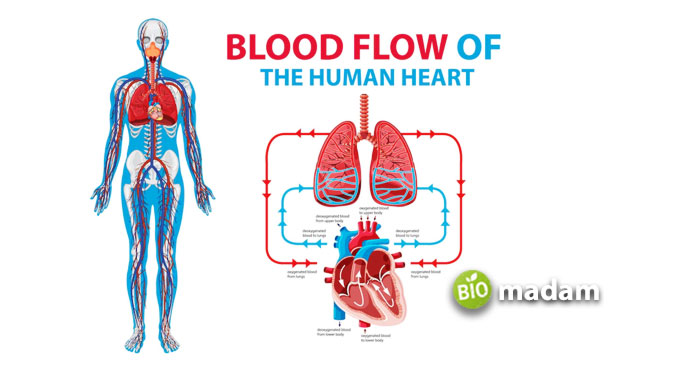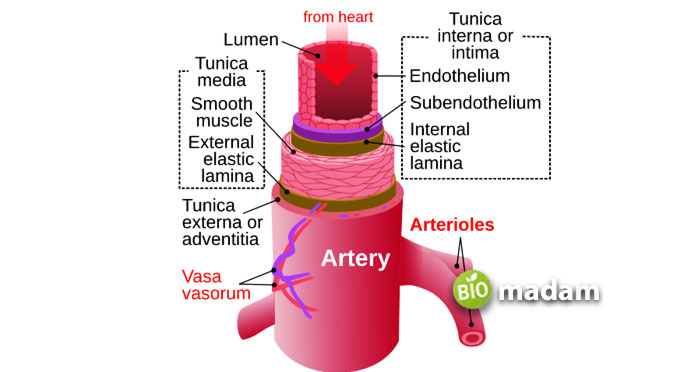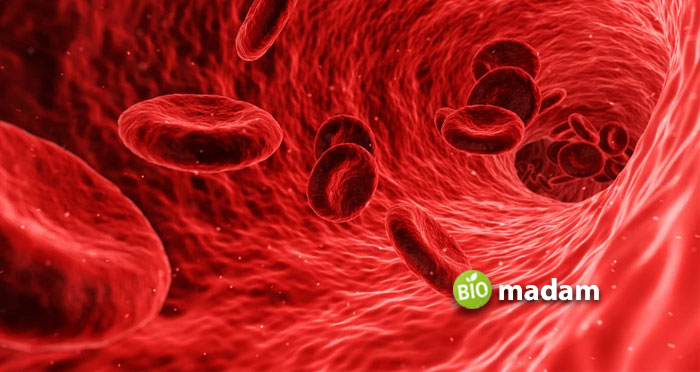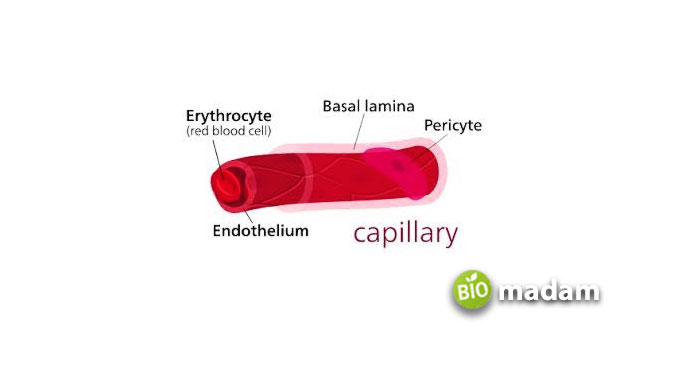The circulatory system is essential to our body’s anatomy and physiology. The blood is the body’s most abundant and critical fluid, comprising white blood cells, red blood cells, platelets, and other molecules. The blood flow in the body is carried out through tubes called blood vessels (arteries, veins, and capillaries) that make up the circulatory system. They facilitate the movement of blood that supplies oxygen and nutrients to the body tissues.
Keep reading about blood vessels and the differences between arteries, veins, and capillaries.
Comparison Table
| Factors | Arteries | Veins | Capillaries |
| Type of Blood | Oxygenated | Deoxygenated | Both |
| Function | Carry blood away from the heart | Carry blood toward the heart | Exchange of nutrients and O2 |
| Layers | Three | Three | One |
| Thickness of Wall | Thick | Thin | Single-celled |
| Lumen | Small | Broad | Thin |
| Pressure | High | Low | Low |
| Valve | Absent | Present | Absent |
What are Blood Vessels?
Blood vessels refer to thin tubes in our body that transport blood to all cells, tissues, and organs. Arteries, veins, and capillaries are the three main blood vessels in the body. The blood vessels begin at the end of the heart. The heart and blood vessels collectively comprise the circulatory system, expanding over 60,000 miles. They provide the body cells with macro and micronutrients and also remove carbon dioxide and waste products from the cells.
The blood vessels do not run in a straight line because of their enormous length. Thus, you cannot see most of them. Some thicker blood vessels may be seen under the skin of your face, hands, and feet. Thicker blood vessels, like the aorta, are around 2 cm wide, while others, like capillaries, are as thin as 2 microns.

What are Arteries?
Arteries are the strongest and thickest blood vessels in the body. They carry blood away from the heart. Arteries are elastic because of the pressure exerted by the blood when leaving the heart.
Structure
Arteries have a smaller lumen for the passage of blood due to their thick walls. The artery walls comprise three layers of different types of tissues. The innermost layer consists of connective and epithelial tissues. Squamous epithelium tissues are covered with elastic connective tissue layering. The second layer in arteries is the tunica media which primarily comprises thick, smooth muscles that help alter diameter according to blood pressure and blood flow. The last (outermost) later is the tunica externa, made of fibrous proteins like collagen and elastin. This layer has the densest connective tissue where it joins to the middle layer.

Function
The main purpose of arteries is to transport blood from the heart to different bodily organs. This is obtained by the combined function of pulmonary and systemic arteries. The systemic artery carries oxygenated blood from the heart to the body cells and tissues. Alternatively, the right and left pulmonary arteries transport deoxygenated blood from the ventricles to the right and left lung, respectively. The ventricles push the blood into large arteries that branch into smaller arteries called arterioles. The systemic arteries have 10% of the total blood volume at any time.
What are Veins?
Veins carry deoxygenated blood toward your heart and are not as thick as arteries. Veins are closer to the skin and often easily visible. The blood enters the veins through the capillaries.
Structure
Veins have the same three layers as arteries. However, the muscles are less and provide less cushioning. Eventually, the walls of veins are thinner than arteries and have a wider lumen. It allows blood to pass through the large lumen with low blood pressure. However, they have valves that prevent the backflow of blood. The presence of valves in arms and legs is of significant importance. They ensure that the blood does not move to the peripheries under the action of gravity.

Function
Veins obtain the blood from the capillaries and take them to heart. The blood enters the smaller veins and travels to progressively larger veins until it enters the heart. The venous system also comprises systemic and pulmonary veins involved in blood transport toward the heart. The pulmonary veins carry oxygenated blood from the lungs to the heart’s left atrium. On the other hand, systemic veins bring deoxygenated blood from the tissues and organs to the heart. 70% of the blood is present in the veins at all times.
What are Capillaries?
Capillaries ate the tiniest of the blood vessels present in the highest number in the body. The distribution of capillaries in the body varies according to metabolic activity. Metabolically active organs such as kidneys, liver, and skeletal muscles have more capillaries than others. Some body parts, like the eye lens and epidermis, do not have capillaries at all.
Structure
Capillaries are so tiny that you can see them only under compound or electron microscopes. They have thin walls, only around a single cell thick. The walls of capillaries are made of two layers of cells, including endothelial and epithelial cells. The epithelial cells act as a protective layer outside endothelial cells.

Function
They are responsible for maintaining a connection between arteries and veins to facilitate the movement of blood in the body. Their primary function is the exchange of materials and gases between the blood, plasma, and tissues. Capillaries hold 5% of the total blood volume at all times.
Other Blood Vessels
Besides the three major blood vessels, arterioles and venules are also considered a part of the circulatory system. They are smaller than arteries and veins but bigger than capillaries.
Arterioles
Arterioles are the thinnest branch of the artery that further divides into tinier blood vessels leading to the capillary bed formation.
Venules
Venules are the smallest veins. They connect to the capillaries and receive blood. They have post-capillary sphincters to prevent the backflow of blood. Venules also receive nutrients and oxygen from capillaries.
Difference between Arteries, Veins and Capillaries
Type of Blood
Arteries
Arteries majorly carry oxygenated blood. However, the pulmonary artery transports deoxygenated blood.
Veins
Veins take deoxygenated blood from the organs except for the pulmonary vein, which carries oxygenated blood.
Capillaries
Capillaries have both oxygenated and deoxygenated blood as they interact with veins and arteries.
Function
Arteries
Arteries are responsible for taking blood from the heart to the lungs and body organs.
Veins
Veins carry blood to the heart from body cells and lungs.
Capillaries
They contribute to the transfer of nutrients, gasses, and oxygen between blood and tissues.
Type of Tissue
Arteries
Arteries are made of squamous epithelium and elastic connective tissue layering. They are covered with thick, smooth muscles, elastin, and collagen.
Veins
Veins comprise elastic fibers, connective tissue, and smooth muscle cells.
Capillaries
Capillaries have sleek walls comprising endothelial tissues covered with epithelial tissues.
Layers
Arteries
Arteries have three layers in their wall, including tunica adventitia, tunica media, and tunica intima.
Veins
Veins also have three layers in their structure that give them strength.
Capillaries
Capillaries are extremely thin, and their wall comprises only one layer – tunica intima.
Wall Thickness
Arteries
Arteries have the thickest wall among all blood vessels.
Veins
Veins have comparatively thinner walls than Arteries.
Capillaries
Capillaries are the thinnest of all blood vessels, only around single-cell thick.
Lumen
Arteries
Arteries have a smaller lumen because of their thick walls.
Veins
Veins possess wide lumens as their walls are thinner. They provide more area for flow.
Capillaries
Capillaries are only as much as one cell wide.
Pressure
Arteries
The pressure of blood coming from the heart is quite high.
Veins
The blood pressure in the veins is low as the blood moves toward the heart.
Capillaries
Capillaries do not experience high blood pressure due to slow blood flow.
Elastic Fibers
Arteries
Arteries have high amounts of elastic fiber that allow flexibility.
Veins
Veins do not have a high amount of elastic fibers as their lumen is quite broad.
Capillaries
Capillaries lack elastic fibers because they do not experience a high flow of blood.
Valve
Arteries
Arteries do not have valves as the pressure prevents backflow to the heart.
Veins
Valves in the veins and venules prevent blood flow toward the peripheries.
Capillaries
Capillaries do not contain any valves.
The Bottom Line
Arteries, veins, and capillaries are blood vessels facilitating the transport of hemoglobin, types of antibodies, and other molecules in the body. The blood vessels make up the circulatory system that transports blood to all body organs. Important molecules in the blood, including red blood cells, white blood cells, platelets, etc. All blood vessels contribute to the transfer of blood to different body parts. Their unique function is the main difference between arteries, veins, and capillaries. Arteries carry blood away from the heart, veins carry blood toward the heart, and capillaries help in gaseous exchange. The size of the blood vessels also varies, with capillaries being the smallest in size.
FAQs
What is the biggest difference between arteries and veins in terms of function?
Arteries primarily take blood away from the heart, while veins carry the blood to the heart. Arteries have oxygenated blood, and veins have deoxygenated blood. Meanwhile, capillaries facilitate the exchange of gasses.
Why do doctors take blood from veins and not arteries?
Arteries have a higher blood pressure than veins, making it easy to remove blood from veins. Moreover, veins run superficially and have thin walls. Thus, they are preferred when taking blood samples.
What happens if blood capillaries are absent?
The circulatory system moves the blood from the arteries to the arterioles and capillaries, followed by venules and veins. So, if capillaries are not present, it will restrict blood movement to body organs and tissues.
What color is blood without oxygen?
Blood without oxygen (deoxygenated blood) is dark red, unlike the common perception that it is blue. On the other hand, oxygenated blood is bright red as it is rich with oxygen-rich red blood cells.
What is the largest artery in the body?
The aorta is the largest artery in the body that carries blood from the heart to the rest of the body. The blood moving through the aorta is oxygen-rich to supply oxygen to other organs.

Anna has completed her degree in Pharmacy from the University of Hawaii. She is serving as a research assistant in a pharmaceutical company. She had a great interest in writing blogs, traveling to different parts of the US, and trying delicious recipes in her spare time.

